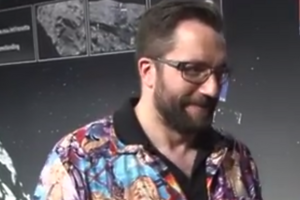Philae fashion faux pas: Rosetta scientist apologizes for offensive shirt
Rosetta scientist Matt Taylor chose a bowling shirt covered in buxom leather-clad babes to update the world on the first-ever comet landing. Women in the scientific community were not amused.

Rosetta scientist Matt Taylor angered women in the science community Tuesday by wearing a shirt featuring scantily-clad women during interviews about the historic Philae landing on a comet.
Screen grab from YouTube
[Update: Rosetta scientist Matt Taylor took a moment during Friday morning’s press briefing on the progress of Philae to offer a tearful apology for the offensive shirt he wore during Wednesday’s briefing.
"Right, um, the shirt I wore this week, um, I made a big mistake and I offended many people. I'm very sorry about this," Dr. Taylor said before wiping away tears, taking a few breaths to steady himself, and offering his update on Rosetta’s progress tracking Philae.]
It was the biggest international astronomy story since the moon landing. Rosetta's lander was about to touch down on a comet hurtling through space. And while the world eagerly waited to hear if Philae managed to successfully land on 67P/Churyumov-Gerasimenko, Rosetta scientist Matt Taylor filled the eager populace in on the challenges involved in the monumental task.
And what did Dr. Taylor choose to wear for this historic occasion? Maybe a lab coat? Or perhaps a sharp button down? No, the voice of the Rosetta mission showed up in a loud bowling shirt that was not only garish, but was also slathered in buxom, leather-clad, anime babes. Women in the scientific and science writing community – many of whom have spent their careers attempting to shatter conceptions that women are not welcome in science – were less than amused.
"No no women are toooootally welcome in our community, just ask the dude in this shirt," tweeted The Atlantic's Rose Eveleth.
Women have long been underrepresented in science and many of the historic contributions to science made by female researchers have frequently been minimized or misattributed to their male colleagues. In recent years, some have argued, most notably renowned economist and former president of Harvard University Larry Summers, that women are not equally represented in the sciences because they simply aren't interested in science. However, advocates of women in science have argued that girls and women are discouraged from pursuing science and when they do, they run into double standards, discrimination, and outright harassment.
“Not only did Taylor not ask himself whether it was appropriate, none of his colleagues seemed to either (or if they did, they were ignored),” The Guardian’s Alice Bell wrote in her response to the choice.
A recent study published in the open-source journal PLOS ONE in July found two thirds of young scientists endured sexual harassment while working in the field. One quarter of female scientists surveyed reported experiencing some level of sexual assault.
While Taylor's choice of attire doesn't come anywhere close to that line, critics argue that the images on the shirt hardly create a welcome working environment for female scientists, not to mention the female science reporters covering the event and the young girls all over the world watching from their homes and classrooms.
As Ms. Bell noted in her piece for The Guardian, the fact that no one questioned Taylor's choice of attire raises eyebrows about more than just one sartorial decision.
All of this raises multiple questions, not least why people in science aren’t routinely trained to be more aware of such issues. This goes for Taylor, but also the multiple staff around him, including my colleagues in the science press.
So far, Taylor has avoided comment on the incident. He did don a much more subdued black t-shirt for this morning's press conference.

